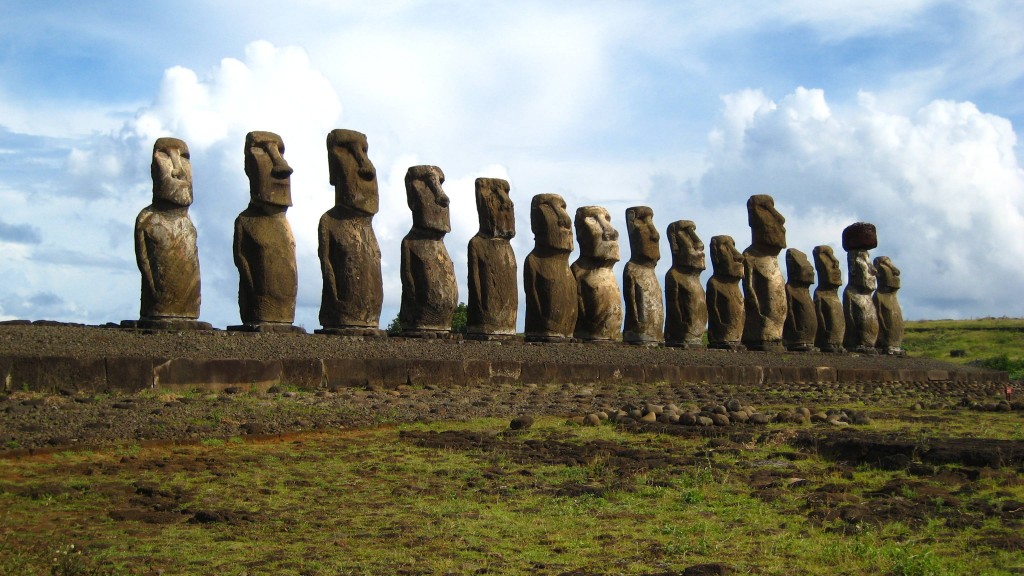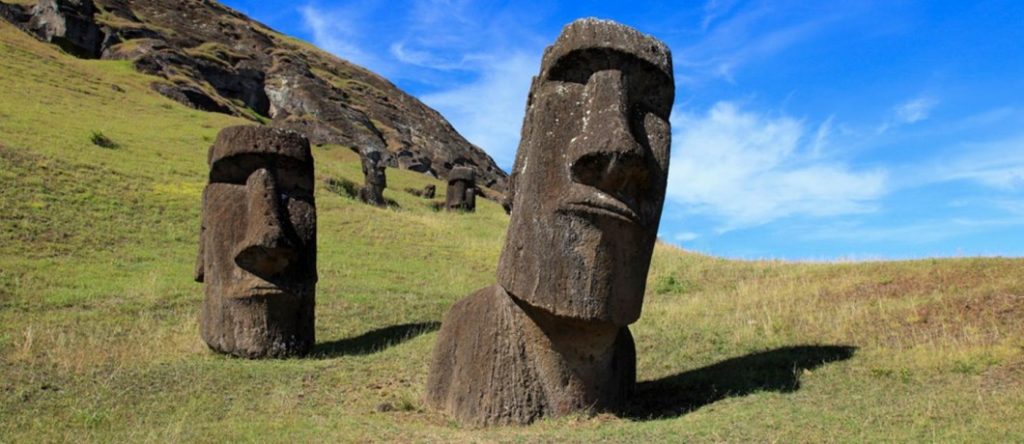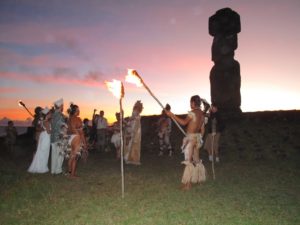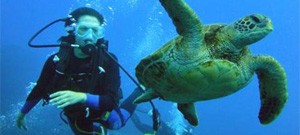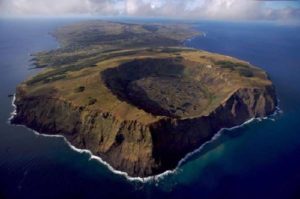
Forming part of the Polynesian Triangle, Easter Island might seem an odd territory for Chile to have. But it is a land and culture that Chileans are particularly proud of and is one of the most curious to visit. The history of the island is utterly unique, and it holds plenty of intrigue for visitors from all over the world.
With a mild climate and beautiful palm-fringed beaches, the Island is a pleasure to visit for its mountainous climbs and picturesque coves. Although the majority of visitors come here for something else: for the Moai. These iconic rock sculptures are one of the many rarities of this unusual and fascinating island…
The History: Rapa Nui and the Moai
The people who have lived on Easter Island since it was first inhabited, perhaps since 300AD, have not had an easy life. The islanders have suffered civil wars, slave raids, colonialism, famine, epidemics and the island reached almost complete deforestation!
The native inhabitants are known as the Rapa Nui and it is believed that they were most likely Polynesians who arrived to the islands by canoes over a millennia ago. They were organized in tribal groups with different clans and a high chief controlling all nine of the clans. It was during this early period between 1250 and 1500AD that the Moai were constructed.
These imposing and mindboggling statues are believed to have been built to honor deceased ancestors and chiefs. The stone totems would protect the island and were erected on the shores of Easter Island looking inwards, with their backs to the spirits out at sea and their eyes facing the islanders inland. The only exceptions were seven Moai facing the sea to help travellers find their way here.
The Rapa Nui people created 887 statues over the centuries and erected half of them, while the other half still remained in the quarry waiting for erection. How they managed to transport this enormous and heavy Moai across the island and stand them in place is considered a remarkable feat. The largest Moai erected was almost 10 meters tall and weighs over 82 tons! This is only half the size of another Moai, which was left incomplete, that would have been over 21 meters tall and 270 tons when finished!
From a distance they may just look like large heads, but the Moai had small bodies carved beneath too. Each one was usually carved from a single piece of rock and transported across the island in one piece (although especially sacred Moai have a red rock headdress on top).
No one knows exactly how the Moai were moved to their destinations as no records remain from this period. One thing is certain though, it would require between 50 and 150 people to move each Moai. Many archeologists believe that the Rapa Nui people created log rollers to transport them. Coincidentally the island suffered almost complete deforestation, which is perhaps why the Rapa Nui people stopped constructing Moai. Originally the island was estimated to have 16 million trees, but by 1877 there were just 111 trees! Deforestation also created a big problem for building fishing boats, which led to a food crisis and arguments between clans.
It was these arguments that led to the demise of the Moai. People began pushing over the totems of the other clans and before long, all the Moai were facing the floor or broken. Not one was left standing!
The fallen Moai was not the end of the fighting on the island though, a huge battle between the two remaining tribes – known as the ‘long ears’ and the ‘short ears’ – began. Legend says that the ‘long ears’ were losing to the ‘short ears’ and so they created a large ditch to push the ‘short ears’ into and kill them by setting them on fire. However as the legend goes, a young ‘long ear’ woman was in love with a ‘short ear’ man, and so told him the secret plan so he could escape. The young man told the rest of his tribe, and the ‘short ears’ planned a secret attack on the ‘long ears’. The ‘short ears’ managed to kill all the ‘long ears’ in the battle and eradicated the other tribe.
However it is very difficult to know the true facts. In 1862, slave ships and missionaries arrived to the island capturing the remaining Rapa Nui natives and destroying all evidence and cultural remnants of the past. So the story of the Rapa Nui remains a mystery, with only the enigmatic Maoi as curious evidence for this rich cultural history.
Nowadays on the island, you can see many of the Maoi re-erected to show how the island used to look. They are the reason why Easter Island is a UNESCO Heritage Site. The stone eyes of the Moai are the only eyes in the world that have witnessed the true story of Easter Island.
What to do on Easter Island
Moai Visiting
Of course visiting the Moai is the top attraction on Easter Island. There are many sites around the island to see the Maoi standing and also on the ground. You can also visit the small Sebastian Englert Anthropological Museum to get a greater understanding of the history of the island and the Rapa Nui people.
Traditional Dance
Although no pure blooded Rapa Nui inhabit the island anymore, that doesn’t mean the Polynesian and native culture is dead. You can enjoy traditional dance and music in evening shows that give you a taste for the Rapa Nui culture.
The Island Volcanoes
Easter Island has volcanoes dotted all around. The volcano craters had a very important role in the creation of the Moai. It was inside the volcano craters that the Moai were sculpted and you can visit one quarry, Rano Raraku, where you can see several unfinished statues including the largest one, which would have been 21 meters tall!
Trekking
The volcanoes offer some challenging walks on the island. Rano Kau is a favorite distinct volcano to climb as you can visit Orongo village which is where another cult on the island originated, the Birdman cult. The center of the volcano’s crater is a large lake!
Cycling
Because most of the island is flat, it is a perfect place to cycle. Cycling around the island is a great way to visit the different Moai sites, as well as see remains of houses, cemeteries and more modern Catholic shrines.
Snorkelling & Scuba Diving
Easter Island is renowned for its clear waters. With a mild climate year round and warm water in the summer, it is a great place for snorkelling or scuba diving. The pollution-free waters are crystal clear and sometimes have visibility up to 50 meters. You can see many colorful fish as well as sea turtles, and the interesting corals and volcano formations under water.
Beaches
There are some beautiful, unspoiled beaches on Easter Island. With a few palm trees for shade, perfectly blue water and white sand, it is an idyllic setting for long beach walks, swimming and relaxing.
Water sports
Surrounded by the scenic Pacific Ocean, there are plenty of water sports that you can try on Easter Island. Parts of the coast are excellent for surfing, and sailing is a popular activity as well as kayaking. Many cruise ships also come to the island on round the world or South America cruises.
Where to Stay
Hare Noi
With rooms built into the side of the island, many have an excellent view of the sea and a rustic-chic design. Relax in their spa with volcanic stones and a small wading pool.
Explora Rapa Nui
With an adventurous itinerary of excursions around the island you can discover Easter Island on full day hikes, bike or by boat ride. Finish the day with a cocktail in the cozy all-inclusive bar, or with a swim in the outdoor infinity pool.
Hotel Taura’a
For a good value B&B, try Hotel Taura’a. Located near most of the restaurants, bars and rental shops in Hanga Roa town, this has a very convenient location. Rooms are simple, breakfast is plentiful and the owners are very friendly and helpful.
Getting There & Around
Unless you are travelling on a cruise, you’ll need to fly to Mataveri Airport which is located in the main town on the island, Hanga Roa. LAN Airlines has daily flights to Mataveri flying from Santiago (Chile), Papeete (French Polynesia), and Lima (Peru). From Santiago it is a 5 hour flight.
You can either hire a car, a bike or a private car and driver to explore the island by yourself. If you prefer to join tour groups to explore, there are many agencies based in Hanga Roa.
